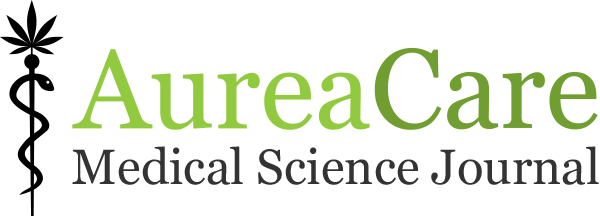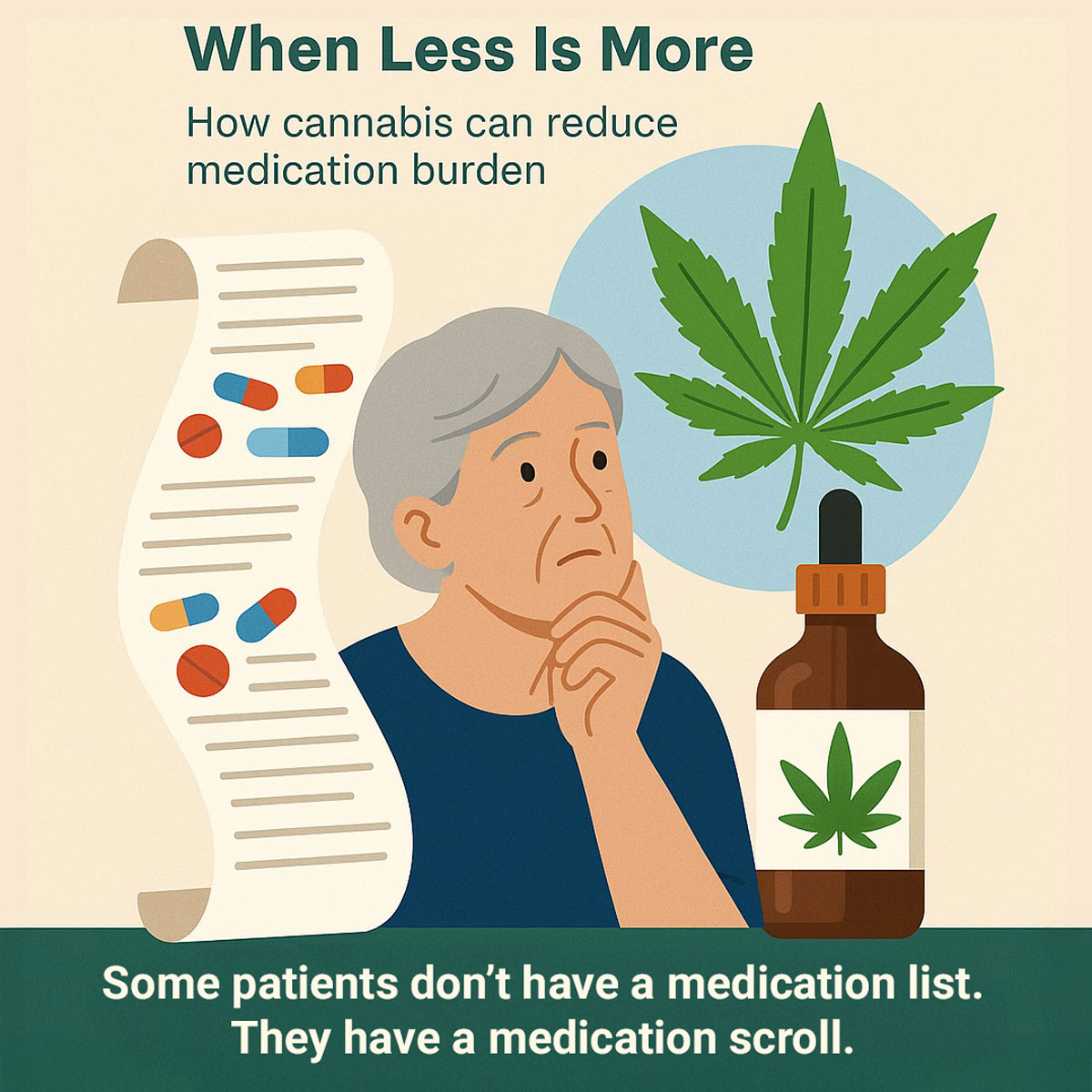How cannabis can reduce medication burden
Author: Dr. Kim, Medical Doctor at Aurea Care (Pen name)
Some patients don’t have a medication list. They have a medication scroll.
You’ve seen this patient. A 68-year-old lady with chronic pain, insomnia, hypertension, anxiety, reflux, and a care team that stopped communicating sometime around 2017. She’s on tramadol, zopiclone, oxascand, venlafaxine, gabapentin, a statin, an H2-blocker, a proton pump inhibitor (yes, that’s two acid meds), a beta blocker, a laxative, and a few mystery drugs no one remembers prescribing.
This is polypharmacy: the concurrent use of multiple medications, often five or more, typically prescribed by different specialists for different problems—without a unifying strategy. Sometimes necessary. Often well-intentioned. But increasingly, a warning sign that the patient’s complexity has outgrown the one-problem-one-pill approach.
And here’s where cannabis might help—not by doing everything, but by doing enough.
Used wisely, cannabis can sometimes let us subtract instead of add. Lighten the pharmaceutical load. Simplify tangled regimens. Restore a bit of clarity. But it’s not a free pass. There are risks, interactions, and caveats to cover.
And that’s what we’re going to do here.
The Problem with Piling On
Polypharmacy isn’t just annoying. It’s dangerous.
Once a patient crosses the threshold of five daily meds (a definition now common in the literature), the odds of adverse drug events, hospital admissions, and functional decline rise steeply. Double that, and you’re no longer managing disease—you’re managing side effects of the management.
The dangers aren’t subtle:
- Side effects masquerade as new diagnoses: dizziness becomes “vertigo,” constipation becomes IBS, fatigue earns another antidepressant.
- Pharmacokinetic chaos: CYP450 enzymes get pulled in five directions at once, altering drug levels in unpredictable ways.
- Additive sedation: especially from CNS depressants like benzos, Z-drugs, antihistamines, and opioids. One is risky. Three is a hip fracture waiting to happen.
- Non-adherence: not because patients are non-compliant, but because they’re human. Twelve meds a day is a part-time job.
And some of the most enduring medications on a patient’s list started with, “Let’s just try this.” It might’ve helped. Or not. But it stuck—because in the absence of obvious harm, inertia is easy.
Most common example? Aspirin. A cardiovascular souvenir that’s been riding an untold number of patients’ med lists since the Clinton administration without anyone revisiting why it’s still there.
Nobody questions it, because nobody remembers the original question.
Sometimes the original problem is gone. Sometimes a drug was added to fix the side effects of another drug. And sometimes, a medication just lingers like background noise—not helping, not hurting enough to trigger concern.
This isn’t rare.
This is Tuesday.
Enter Cannabis: A Shortcut That Simplifies
Not as an extra line on the scroll, but sometimes, a way to shorten it.
Cannabis doesn’t fix everything. But for the right patient, it can do the work of two or three meds—with fewer side effects, better sleep, less sedation, and often more dignity. Especially in the zones where polypharmacy is thickest: pain, sleep, anxiety, and the mess where all three overlap.
Pain: Tapering Opioids with Cannabis
Chronic pain patients are often on a cocktail of opioids, antidepressants, antiepileptics, and NSAIDs—none of which were designed for long-term use (no, not even in complex pain syndromes).
Cannabis, especially in balanced THC:CBD formulations, can reduce pain intensity, spasticity, and neuropathic symptoms without the sedation, constipation, or rapid tolerance that opioids tend to bring.
Many patients find they can taper or even discontinue opioids after starting cannabis. Not because cannabis numbs them more, but because it works differently: modulating pain through the endocannabinoid system, rather than just hammering the opioid receptors until the pain adapts, the bowels riot, and nobody’s winning.
The pain may still be there. But it stops screaming. It becomes background music instead of a fire alarm.
Sleep: Trading Pills for Plants
Let’s get something straight: there’s no such thing as a sleeping pill.
What we call “sleeping pills” are in medical jargon known as hypnotics—drugs that knock you unconscious. That’s not the same as real sleep. Sure, you’re horizontal and not answering emails, but what your brain’s actually doing in there is… debatable.
The most common hypnotics—Z-drugs like zopiclone, benzodiazepines, sedating antihistamines, and sometimes even low-dose antipsychotics—don’t induce or even deepen sleep. They sedate. And all with a catch: tolerance, dependence, rebound insomnia, next-day fog, or—in older patients—a midnight trip to the bathroom that ends in a fractured hip.
They reduce sleep latency, yes—but only by a little. And more importantly, they suppress REM and slow-wave sleep: the two stages your brain needs to repair tissue, consolidate memory, regulate emotion, and reset your stress response.
You wake up feeling rested not because the work of sleep got done, but because adenosine—the molecule that makes you feel sleepy—got flushed out. The fatigue’s gone, but the hard drive never defragmented.
In other words: you’ve been chemically duct-taped to the mattress. The factory lights are off, but the janitors never came in. So the cobwebs remain.
Are these meds always bad? No. Used strategically, they can help. Not by restoring healthy sleep, but by giving someone a break from insomnia-induced misery. When sleep deprivation is driving someone to the brink, unconsciousness is a therapeutic compromise. A good doctor prescribes “sleeping pills” for relief, not restoration. The goal of “sleeping pills” isn’t even to fix sleep—it’s to make life livable when sleep has gone completely off the rails.
Enter cannabis.
Cannabis doesn’t knock you out. It nudges.
- Low-dose THC shortens sleep latency and increases time in deep (N3) sleep, without crushing REM the way hypnotics do.
- CBN, a breakdown product of THC, adds a soft sedative effect.
- And CBD, at low-to-moderate doses, helps reduce pre-sleep anxiety and hyperarousal without the chemical sledgehammer. This is especially useful when the problem isn’t sleep itself, but getting into a state where sleep can happen.
Is cannabis perfect for sleep? No. High doses of THC can still suppress REM. High doses of CBD can promote wakefulness. Dose, ratio, and timing matter. Used poorly, it’s just another crutch. But used well? It’s a crowbar for racing minds.
And unlike many sedatives, cannabis doesn’t flatten REM across the board, doesn’t lock you into one sleep stage, and rarely requires ever-increasing doses to work. Patients often wake up clearer, not groggier. No pill hangover. No tolerance spiral.
When it works, it’s not lights-out via chemical knockout. It’s more like the nervous system finally takes a breath and says, “Okay… we can sleep now.”
Anxiety and PTSD: A Softer Edge
Benzos are fast, but addictive. SSRIs are slow, and often blunt emotion. Both carry heavy baggage.
Cannabis, when used carefully, offers middle-ground relief: faster than SSRIs, gentler than benzos.
CBD is the mellow diplomat among cannabinoids. It doesn’t knock you out. It doesn’t flatten emotion. It reduces anxiety by modulating the 5-HT1A serotonin receptor, calming the amygdala, and restoring tone to a nervous system stuck in red alert.
That’s the real trick: it doesn’t erase emotion. It helps your brain stop treating every emotion like a bear attack.
The amygdala is your brain’s alarm system. It’s ancient, jumpy, and—thanks to modern life—wildly overcaffeinated. (Not literally, but you get the idea.) It’s the part responsible for fear, panic, and catastrophizing things that don’t need to be catastrophized. CBD tells it to take a breath. Maybe lie down. Drink some water. And cool it with the espresso.
THC is trickier.
In safe settings and low doses, it can ease anxiety and loosen the grip of hypervigilance—especially in patients with PTSD or chronic trauma. In high doses or unpredictable environments? It can make anxiety worse. That’s why titration matters. It’s a dimmer switch for anxiety, not a power outage.
Many patients with PTSD or long-standing anxiety describe cannabis as the first thing that made their nervous system stop sounding the alarm. Not off. Just quieter.
And when that happens, something else becomes possible: deprescribing. That means they can finally start trimming their medication list. The typical polypharmacy cocktail of benzo, SSRI, beta blocker, and antihistamine starts to shrink. Fewer pills. Fewer side effects. More room to breathe.
Because when cannabis works, it lowers the volume on anxiety—and helps clear out the pharmaceutical clutter.
A Note of Caution
Cannabis isn’t a miracle drug. And it’s not a straight swap for everything else in the medicine cabinet. Here’s what to watch:
- Drug interactions: Cannabis can inhibit CYP450 enzymes, which means it can alter the metabolism of drugs like warfarin, clozapine, and certain antidepressants. Always double-check.
- Sedation: Combine it with other CNS depressants and you might get more drowsiness than you bargained for.
- THC sensitivity: Some patients—especially older adults—may get dizzy, anxious, or mentally foggy on doses others tolerate just fine.
- Withdrawal risk: Deprescribing benzos, opioids, or certain antidepressants still requires care. Cannabis doesn’t erase withdrawal, it just might make it easier to navigate.
Deprescribing is an art. Cannabis can help, but it’s not a cheat code. It’s a new route. And like any new route, it works best with a map.
Final Thoughts: Subtraction as Therapy
In medicine, we’re trained to add. To escalate. To stack treatments like sandbags. But sometimes, the most therapeutic act is subtraction.
Cannabis, when used wisely, lets us do just that. Not by numbing, but by helping the nervous system self-correct. Pain dials down. Sleep deepens. Anxiety lets go. The list gets lighter.
It cuts the pill count and brings clarity back into the room. And in a world where polypharmacy is the default, clarity is medicine.
It’s not radical. It’s just good medicine.

